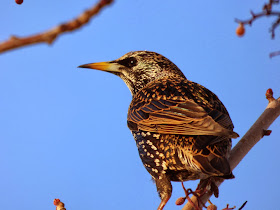The first, and one of my favorite recent pictures, is a Western Scrub Jay (Aphelocoma californica) making a meal out of a pecan. The scrub jays are obnoxious and raucous, and at constant war with our cat in the backyard, but they are also a bright splash of color, and are one of my favorites.
The Snowy Egret (Egretta thula) is a fairly common wetlands inhabitant in our area. They are one of the most graceful birds I see on a regular basis, standing very still will getting ready to stab at fish or amphibians in shallow water (like they did when they got the goldfish in my pond...).
I keep a feeder in the backyard, and it attracts three or four varieties of finches, including the House Finch (Haemorhous mexicanus), the Goldfinch (Carduelis tristis), and the Lesser Goldfinch (Carduelis psaltria). They like their sunflower and nyjer seeds and they are quite vocal in their complaints when I let the feeders go too low.
I thought the gray bird in the picture below was a mockingbird from a distance, but some of my facebook experts suggest that it is a Western Kingbird (Tyrannus verticalis). I am open to being corrected in this identification.
True to the season, here are two doves, but they aren't turtle doves. I was told (and agree) that these are Eurasian Collared Doves (Streptopelia decaocto). It is an relatively recent invasive species that I have constantly mistaken for Mourning Doves.
On a brief foray along the Tuolumne River near La Grange we found an American Kestrel (Falco sparverius) watching for a meal from a telephone pole.For ten years I've been trying to catch a photo of a Yellow-billed Magpie (Pica nuttalli), a species unique to California (it is a cousin to the Black-billed Magpie found in much of the rest of the country). They have been very shy when I come around with a camera, but one hung around for a moment before flying away the other day. They've been decimated by the West Nile Virus.
I am familiar with the story of how European Starlings (Sturnus vulgaris) arrived in America to become a pest (it was a Shakespeare lover of all people), but I had never noticed them around my neighborhood until I started walking a few weeks ago.
The Killdeer (Charadrius vociferus) is a widespread species found all over the Americas, but it holds kind of a special place in our valley. We chose it to be part of our banners and symbols for the new Science Community Center at Modesto Junior College. As if to play the part, a Killdeer set up a nest on the vacant lot north of our building that will eventually become our Outdoor Nature Laboratory. I often hear them when I walk around the campus.
There must have been a dozen of them running about the cow pasture a few blocks from my house.
The biggest surprise in my recent walks was the drumming of a woodpecker. I've never noticed any near my house, but walking under a telephone I heard one pecking away.
A bit of research suggested that it might be a Nuttall's Woodpecker (Picoides nuttallii). It's the second kind I've seen in the region so far (the other is the Acorn Woodpecker, farther up in the mountains).
The small bird wandering in the grassland appears to me to be an American Pipit (Anthus rubescens), but I await your confirmation. They hide well, so I've never noticed them before.
The other of many pleasant surprises has been the spotting of some Western Bluebirds (Sialia mexicana) in the trees around the cow pasture. I don't think they've visited our bird feeders.
The pictures I took the other day show a brightly colored male (above), and a slightly more drab female (below). I'd like to see more of them!
I've enjoyed paying more attention to our local bird life, and look forward to adding more of them during my travels. Once again, have a wonderful Christmas and restful holiday!
















I'm inclined to think that you are right about the gray bird being a mockingbird. It is hard to be sure from that photo, but the bill shape is not right for a kingbird and the head shape and body proportions are also more mockingbird-like than kingbird-like. The posture is good for a mockingbird as well.
ReplyDeleteGreat shots! I think your second bird is actually a Great Egret (Ardea alba) based on the relatively deep orange bill. Snowy Egrets have a more slender darker bill, with an orange/yellow mask.
ReplyDeleteI agree with Katrina that the gray bird is a Mockingbird. Bluebirds rarely visit feeders since they feed largely on insects and worms, although you can buy special bluebird feeders and stock them with mealworms.
As always, I bow to the greater expertise of others in bird identification. Thanks for your help! I'm eventually going to get pretty good at this...
ReplyDelete